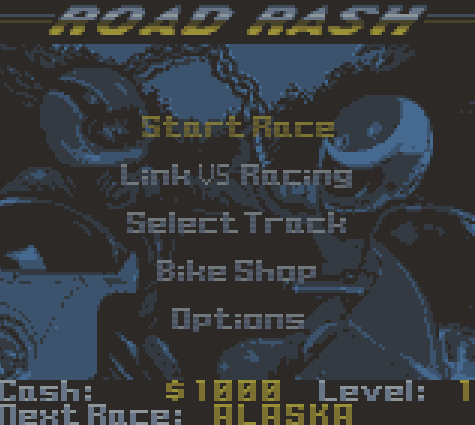Allister Brimble is a video game composer whose career spanned many systems, styles, and decades, starting on the humble micro-computer scene and still kicking today with other games and tribute albums to other chiptune greats. I recently had the opportunity to talk with Allister about his time during the late 90’s scoring Game Boy Color games such as Ghosts ‘N Goblins, Chicken Run, Road Rash, Tom & Jerry in Mouse Attacks… etc.
Talk a bit about yourself and what got you into game composition.
Many years ago, when I was about 16 years old, I used to play video games on a ZX Spectrum computer. The sound was very simple, so when composers such as David Whittaker & Tim Follin made them sound good it was quite an experience! It inspired me to have a go myself. I used to record David Whittaker’s music onto a tape and slow it down to work out how he achieved it. Soon I bought an Amiga computer and started to play with the music and sent some demos to 17-Bit Software, a public domain software group. They liked my demo and decided to publish it! Public domain software is a little bit like YouTube today, where you can show your stuff for free but everything was distributed by post on a 3.5 inch disk. Soon I was creating music for their games, released under the Team 17 label and things went on from there!

What got you into composing for the Game Boy / Game Boy Color later down the system’s life? What was your workflow like for music and sound effects? A few websites mention you **not** using Nintendo’s documentation and/or tools.
Early on in my career I was asked by Codemasters Software to create music for the NES – I had no clue how to do it, so they invited me to their studio and showed me how it was all typed in, a note at a time, on a text editor! I learnt about the sound system and produced music for several of their NES games.
It turns out the NES has the same sound chip as a Game Boy! (Editor’s note: while they have similarities, the NES and Game Boy don’t actually use the same sound chip, but similar tools can be used for composing for both of them) Soon after this, Fergus McGovern from Probe Software contacted me to make music for Mortal Kombat on a Game Boy. I used Jeroen Tel’s sound driver and learnt more about how to make it sound good.
Later on, my friend and brilliant audio coder Michael Delaney created a sound driver that could do many clever things, much like Rob Hubbard’s C64 SID driver. It also used very few CPU cycles, so it ran very efficiently, allowing more CPU for the graphics & game logic. Before the GBA we used some publically available EPROM writers to test things out, but for GBA I registered with Nintendo and purchased their hardware which made the process of testing much quicker!
The workflow was to create music on an Amiga tracker. I used Delta music as I could emulate the instruments pretty well, including arpeggios, ADSR, and vibrato. I then wrote some code in JAVA that would compress the data and convert it to a list of sequences and notes as text. Finally I would create the NES instruments in text. The instruments were very powerful and allowed tables of any length for volume, pitch and arpeggios! I later added an option to modify the redefinable sample channel on the fly which led to many interesting possibilities!


I was also able to catch up with the previously mentioned Michael Delaney, the man behind Quickthunder, the driver he wrote for Allister. He mentioned the driver’s core functionality was up and running rather quickly, after a couple of days reading the information publicly available on the Game Boy’s sound processor, with refinements such as sound effect support being added later on.
According to him, the driver was named this by Allister because “it needed a cool name”, the driver’s internal name was the rather generic “GB Sound”. Supposedly this is the name under which it was listed as on consoleaudio.com, but the WayBack Machine doesn’t seem to have archived it properly.
Seems like around the time you started out doing composition work for other Game Boy developers, lots of other teams popped up to fill that role, Shin’en, Freaq, and Paragon5, just to name a handful. Any idea what could’ve caused this small market to appear?
The Game Boy has several freely available ROM writing tools available and this made it much easier for small companies to get into developing although they still had to buy the official tools for the game, artists and musicians could work from home with them.
Game Boy was also fairly easy to develop for and many of the coders had already learnt their craft on a ZX Spectrum or C64. Along with good hardware sales this meant that many small companies produced games and there was a big market for audio people! The official audio tools used were very inefficient so our sound driver fit into the market perfectly!
How did you feel about the system’s sound limitations compared to your own scopes as a composer?
Well I had already been composing for an Amiga & SNES which were both sample-based, but my inspiration was still from the 8-bit computers so I was pretty excited to give it go!
It took me a while to get anywhere close to the standard of the C64 composers though. Just shows how good they were!
Previously, you’ve mentioned that the Whistle waveform heard in the soundtrack for Chicken Run is a micro-sample of you whistling; really good hardware use there! Do you remember any other little tricks from doing Game Boy music?
I actually managed to create Pulse Width Modulation that you only normally hear on a C64! The sample channel could be modified on the fly, but would produce a click sound, so nobody did it.
I was pretty excited to discover that if I changed the waveform on the beat of the music, the click was hidden by my bass drum or snare, in fact it made them better! You can hear it in the title theme on Road Rash where I took Rob Hubbard’s Megadrive tunes and turned them into what I thought he should have done if they were on a C64!


You seem to have gone through a few credit names alongside Michael Delaney and Will Davis: “Audio Arts”, “Gameboyaudio”, “Full Fat Productions”, “consoleaudio.com”, etc… Any reason for this to have happened?
Michael Delaney is the coder of the sound driver and makes my music possible!
There was so much work on the Game Boy, I needed to work with someone and my colleague was Will Davis for several projects. We created the joint name of Audio Arts. I also tried to set up a website called GameboyAudio but Nintendo made me take it down due to use of the words “Game Boy”.
You can check out Allister Brimble’s work over at allisterbrimble.com, also many thanks to both Allister and Michael Delaney for agreeing to chat for the interview!

Chiptune goblin, programmer, freelancing composer and #1 Game Boy enthusiast.
(She/Her/They)

